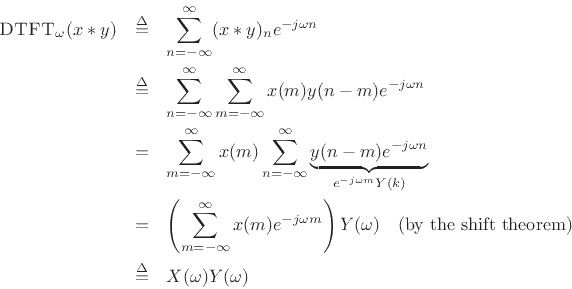Next |
Prev |
Up |
Top
|
Index |
JOS Index |
JOS Pubs |
JOS Home |
Search
The convolution of discrete-time signals  and
and  is defined
as
is defined
as
 |
(3.22) |
This is sometimes called acyclic convolution to distinguish it
from the cyclic convolution used for length  sequences in
the context of the DFT [264]. Convolution is cyclic in the time
domain for the DFT and FS cases (i.e., whenever the time domain has a
finite length), and acyclic for the DTFT and FT cases.3.6
sequences in
the context of the DFT [264]. Convolution is cyclic in the time
domain for the DFT and FS cases (i.e., whenever the time domain has a
finite length), and acyclic for the DTFT and FT cases.3.6
The convolution theorem is then
 |
(3.23) |
That is, convolution in the time domain corresponds to
pointwise multiplication in the frequency domain.
Proof: The result follows immediately from interchanging the order
of summations associated with the convolution and DTFT:
Next |
Prev |
Up |
Top
|
Index |
JOS Index |
JOS Pubs |
JOS Home |
Search
[How to cite this work] [Order a printed hardcopy] [Comment on this page via email]
![]() and
and ![]() is defined
as
is defined
as

